- 1State Key Laboratory of Environmental Criteria and Risk Assessment and State Environmental Protection Key Laboratory of Simulation and Control of Groundwater Pollution, Chinese Research Academy of Environmental Sciences, Beijing, China
- 2Department of Environmental Sciences and Engineering, College of Resources and Environmental Sciences, China Agricultural University, Beijing, China
The presence and bioavailability of potentially toxic elements in the soil–plant system are major limitations to the application of compost to agricultural soils. In this study, the content changes of nutrients and potentially toxic elements in four organic wastes, namely household waste, sewage sludge, chicken manure, and cow/sheep manure, were analyzed during composting, and the quality of compost products was assessed in view of their impact on the environment. The objective of this study was to determine the evolution of 21 metal elements, including macroelements (Na, K, Ca, Mg), microelements (Fe, Mn, Zn, Cu, Mo, Ni), and potentially toxic elements (Ti, Al, Cr, Cd, Pb, Sb, Li, Co, Be, In, and Sn) during composting. Results showed that the contents of these elements varied considerably between different organic wastes. The contents of some elements (Na, K, Ca, Fe, Ti, Cu) increased substantially after composting due to organic matter decomposition and weight loss, whereas other elements (Mg, Co, Mo, Cr, In) decreased due to water leaching. The compost obtained was characterized by heavy metal contents not exceeding the permissible limits. Principal component analysis (PCA) was carried out to further analyze the relationships between the studied elements in different organic waste and compost products. The PCA results revealed that the macroelements (Na, K, Ca, Mg) contents negatively correlated with PC1, whereas microelements and potentially toxic elements positively correlated with PC1. From the results of the PCA, it was possible to classify the different compost products.
1. Introduction
Rapid population growth, economic development, and urbanization have caused a worldwide crisis of organic wastes generation in recent years and may cause serious environmental pollution if not treated properly. Global organic waste would increase from 2 billion tons in 2016 to 3.4 billion tons in 2050 (Huang et al., 2021). Compared to landfill disposal, composting is a more socially and environmentally acceptable and economical method for treating these wastes. Composting not only minimizes damage to the environment but also produces economically valuable products from organic wastes (Chazirakis et al., 2023). The application of compost to agricultural soils has many advantages, which include providing a whole array of nutrients for plant growth (e.g., P, N, and organic matter), increasing the presence of beneficial soil organisms, reducing the need for fertilizers and pesticides, and improving the physical and biological properties of soil (Salomon et al., 2021; Nguyen et al., 2022). The use of organic waste compost can promote the development of green agriculture and promote the usage of organic fertilizers rather than synthetic fertilizers. It is important to study the contents and chemical transformations of nutrient elements and potentially toxic elements during the composting process to ensure the maximum retention of nutrient elements in organic fertilizers and provide an empirical and theoretical basis for promoting its development and industrial use in green agriculture.
However, the application of compost also has two sides. In addition to rich nutrients, compost materials also contain a certain amount of toxic and harmful substances, and their accumulation can also have a certain negative impact on the soil environment. Therefore, the agricultural land application of compost is limited by its relatively high heavy metal content (Chen et al., 2023). The uptake of heavy metals by plants from soil and the biomagnification of heavy metals through the food chain may cause both human health problems and environmental concerns (Mohan et al., 2014; Xiang et al., 2021). Composting organic waste can produce physical, chemical, and biological reactions that can change the pH, cause organic matter to mineralize, and create humic compounds (Yan et al., 2023). These changes may influence the distribution of metals in the compost (Jazi et al., 2014; Arshadi, 2015). Due to microbial decomposition of organic matter, compost loss of carbon and water, and heavy metals not only do not decompose during the composting process but frequently grow more concentrated. In contrast, various activities during composting, including as complexation with and sorption on organic matter, microbial immobilization, oxidation, and leaching, can reduce metal bioavailability (Xu et al., 2021). Given this issue, it is necessary to conduct dynamic process analysis of nutrient elements and potentially toxic elements during the composting process, in order to better control harmful substances such as heavy metals in composting materials and fully leverage the advantages of composting.
Although there have been relevant studies on the content and bioavailability of nutrient elements and potentially toxic elements in the composting process (Chen et al., 2022; Li et al., 2022), it is unknown whether there are fluctuations and differences in the content of these elements between different types of organic wastes being composted. The composition of different organic wastes is complex and varies considerably, which leads to different microenvironmental change mechanisms during the composting process, which in turn have differential effects on the dynamic processes governing elements speciation and mobility. Therefore, it is crucial to study and elucidate the differences in changes in nutrient elements and potentially toxic elements contents during the composting of different organic wastes.
Therefore, in this study, four types of organic wastes (household waste, sewage sludge, chicken manure, and cow/sheep manure) were selected as compost materials. During the composting process, a range of elements were analyzed over time to evaluate changes in their contents in the different organic wastes. In total, 21 elements were monitored, and for convenience of discussion, 21 elements were divided into macroelements (Na, K, Ca, Mg), microelements (Fe, Mn, Zn, Cu, Mo, Ni), and potentially toxic elements (Ti, Al, Cr, Cd, Pb, Sb, Li, Co, Be, In, and Sn). These potentially toxic elements include elements that are toxicants with no known biological role (e.g., Cd, Pd, and Be) and elements that may be beneficial or toxic depending on content (e.g., Co). These data were collected with a view to providing a basis for the more resourceful and rational application of different organic wastes in composting and their subsequent use in agriculture.
2. Materials and methods
2.1. Composting process and sample collection
Household waste (HW) used for composting was obtained from Beijing Asuwei Composting Plant, China. Daily HW disposal at the factory amounts to 800–1,000 t. The dimensions of the compost pile were 3.0 × 2.5 × 1.6 m (length × width × height), comprising organic solid waste in excess of 2 t. Before the 21st day, a forklift would turn the compost pile every 2 days. After the pile had gone through the maturation stage, which took 30 days, it was mechanically rotated every 7 days until the composting process was finished on day 90. To guarantee the composting process was effective, the original water content was changed to between 65–70% (w/w), the C/N ratio was maintained at between approximately 25:1 and 35:1, and the average particle diameter of all raw materials was between 1.5 and 3.0 cm. The inner temperature of the compost increased to 69°C after the 4th day of composting, this was followed by an approximately 30-day cooling interval. The compost had a 17.9\u00B0C/N ratio at the end of the composting period. Three parallel tests were performed for each compost test. Each sample (1.5 kg) was made up of composite samples obtained in triplicate from the top, middle, and bottom of the compost pile, which were collected on 0, 7, 14, 21, and 51 days, respectively. Before analyzing the makeup and evolution of nutrient elements and potentially toxic elements, the samples were air-dried, powdered to pass through a 0.25 mm screen, and kept in a desiccator.
Sewage sludge (SS) was collected from a wastewater treatment plant in Huarong County, Hunan province. The composting was conducted using SS with a moisture content of 80% and corncob with 15% moisture content as a raw material. The addition amount of corncob was 15% to control the moisture content of the compost mixture to maintain at 60–70% (w/w), and the moisture content was determined by drying in a 105°C oven until the mass was constant. Commercial microbial inoculants (0.5% v/v) were added to the compost pile. The dimensions of the compost pile were 3.0 × 2.5 × 1.6 m (length × width × height). After the completion of the maturation stage, which took 60 days, the pile was mechanically turned every 7 days to promote contact between the compost material and air until the end of the composting process on day 90. Three parallel tests were performed for each compost test. After 0, 7, 14, 26, and 60 days of composting, triplicate composite samples were obtained from the top to the bottom of the piles.
The chicken manure (CM) composting process was carried out with specialized equipment, primarily consisting of a cylinder roughly 330 mm wide and 400 mm high. A 6 mm tube was linked to the top of the equipment, and the bottom consisted of a perforated metal plate to hold the composting mixtures and allow for the equal distribution of air. The reactor received air from the bottom through a blower that was attached to the composting system. A detector for measuring the temperature of the composting mixes was installed on the cylinder’s wall. Fresh CM was acquired from a chicken farm in Changping District, Beijing, China. As they contain a relatively high C content, sawdust and dried grass were employed to bulk up the mixture and modify the C/N ratio. In composting piles, the weight ratio of fresh CM, sawdust, and dried grass was 6: 2: 1. The moisture level of the composting mixture was regulated at 50–60% (w/w), and the C/N ratio in the piles was around 26. Three parallel tests were performed for each compost test. During the composting process, triplicate composite samples were collected at different points from the top to the bottom of the piles after 0, 8, 16, 28, and 40 days.
Samples of compost made from cow/sheep manure (SM) were purchased from Zhangjiakou Jinnong Biotech Co., Ltd. in Zhangjiakou, China. The company was established on April 4, 2008, and its annual output of mature compost is roughly 105 t. The fermentation process was carried out in grooves, and the ingredients for composting primarily consisted of cattle manure. The entire composting process lasted approximately 41 days, during which time the composted materials were forked over several times to maintain aeration. We had no control over the composting operation and made no attempt to influence it. Three parallel tests were performed for each compost test. After 0, 7, 14, 26, and 41 days of composting, triplicate composite samples were obtained from the top to the bottom of the piles. The moisture content was determined by drying in a 105°C oven until the mass was constant.
2.2. Sequential extraction procedure and chemical analysis
The sequential extraction procedure (SEP) utilized in this study was originally developed by Tessier et al. (1979) and is frequently used in other composting investigations. Tessier’s SEP classified soil heavy metals into five speciation, including exchangeable, bound to carbonates, bound to Fe-Mn oxides, bound to organic matter and residual speciation. All of the plastic and glass containers used in the studies were cleaned with deionized water after being pre-soaked in Suprapur nitric acid (Merck) overnight. Simultaneous elemental analysis of 21 elements was performed on the acid digests by inductively coupled plasma mass spectrometry (ICP-MS) (Spectro Analytical Instruments, Kleve, Germany). A blank was run at the same time as the samples, and the elemental contents in the blank were always below the respective detection limits. All experimental analyses were performed multiple times in parallel. Recovery assays were conducted by spiking subsamples with known contents of the analyte in order to verify the accuracy of the results. The recovery rates ranged from 95 to 105%. Each average result was constructed using a minimum of three analyses, each of which was carried out until the relative standard deviation decreased below 5%. All results are reported on a dry matter basis.
2.3. Statistical analysis
For analytical precision, we repeated the chemical analysis in triplicate for each sample. The average content of different elements in different samples was evaluated using principal component analysis (PCA) with maximum variation rotation using the SPSS 16.0 (SPSS Inc., Chicago, United States) software package, followed by Tukey’s test at p < 0.05. Pearson correlation coefficient between the contents of 21 elements was determined. PCA was used to construct ordination and loading plots. An ordination plot is a map reflecting similarities and differences among the different organic wastes. All figures were developed using the Origin 2019b program (Origin Lab Corp).
3. Results and discussions
3.1. Evolution of macroelements contents during composting of organic waste
Figure 1 illustrates the variation of macroelements (Na, K, Ca, and Mg) contents in different organic wastes during composting. These elements are required for plant growth (Guo et al., 2019; Winkler et al., 2023). Macroelements contents in the composted SM, CM, and SS decreased in the order Ca > K > Mg > Na. Heavy metals are not biologically degraded like the organic components of compost, so compost products become more enriched in metals than the fresh material.
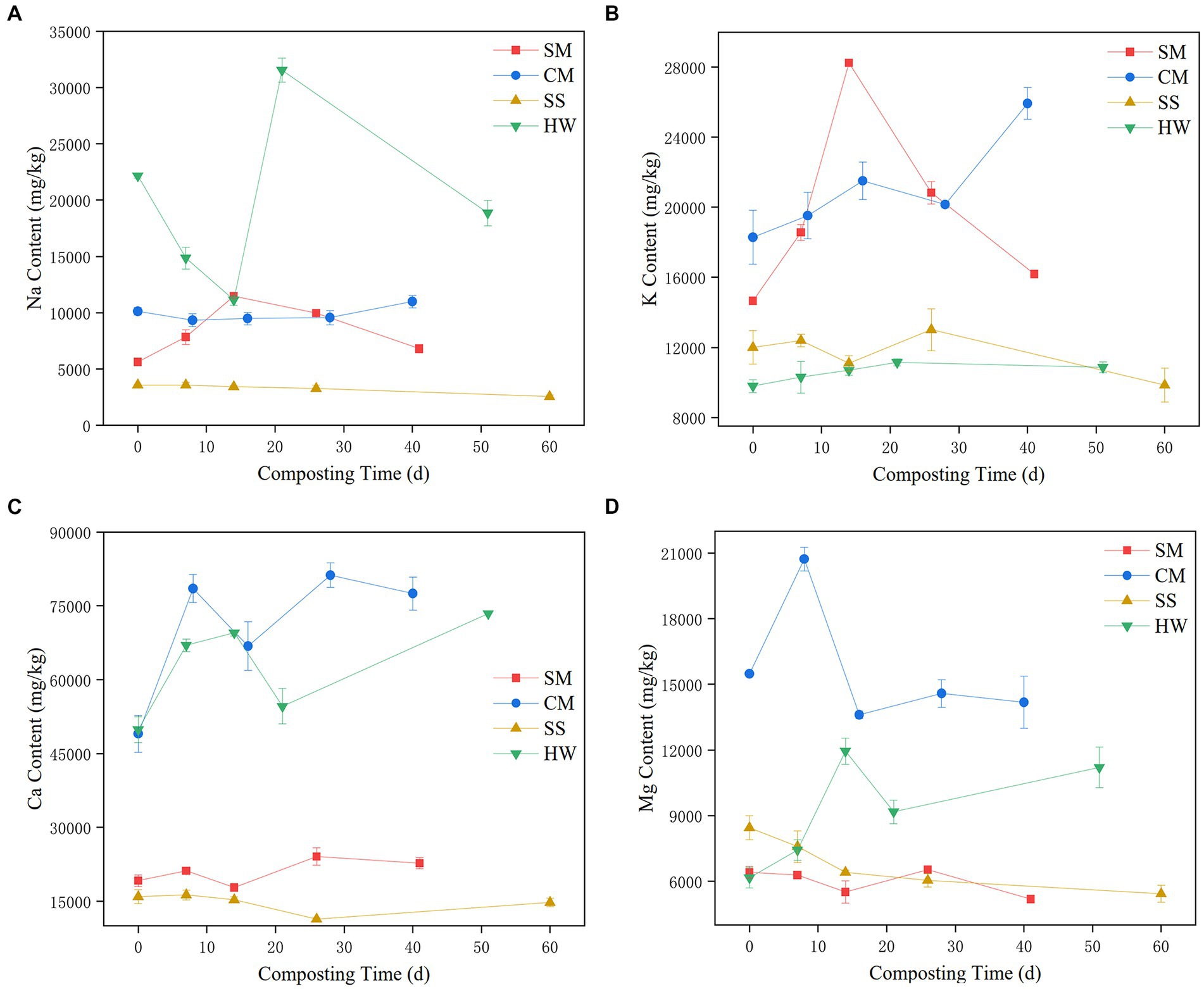
Figure 1. The evolution of macroelements content during composting of organic waste. (A) Na; (B) K; (C) Ca; (D) Mg.
Our study found that Ca contents in the compost samples were much higher than other macroelements and varied from 15,019 mg/kg to 77,446 mg/kg. One of the most crucial elements for biological organisms is Ca, which also supports plant cell structure and improves soil quality. Except in extreme circumstances, Ca has no hazardous effect on human health (Maathuis, 2009; Antonkiewicz et al., 2020).
K in solid wastes was primarily derived from organic and inorganic substances such as ash, vegetable matter, and metals. K was found to be highly soluble in the wastes, where insoluble salts can be solubilized during waste decomposition (Guo et al., 2019). Therefore, K was leached easily. In the present study, there was no significant difference in the initial K content between different organic waste composts. However, the K content was significantly increased by 43.21% in CM after composting. K is a nutrient that is necessary for plant growth and is not known to be toxic or detrimental to humans at contents that are relevant to agricultural sciences.
Domestic, food, and vegetable trash, fine soil, and small-scale industrial wastes were the main sources of Mg in solid wastes. Mg contents varied from 5,518 mg/kg to 14,218 mg/kg. The content of Mg was found to be lower than Ca and K, and, as with Ca and K, Mg is regarded to be nontoxic at the contents relevant to this study.
Organic substances, ash, and inorganic salts were the principal sources of Na in solid wastes (Zhao et al., 2019). High contents (18,970 mg/kg) of Na were found in the HW because it contained kitchen waste with high salt contents, whereas the lowest Na content (2,875 mg/kg) was observed in the SS because the Na was removed from the SS after solid–liquid separation. The increases in these elements were also observed by Manca et al. (2020). Na in the waste was readily leached as Na salts became solubilized during waste decomposition. Up to moderate contents, Na does not cause adverse effects, but at higher contents, it may affect soil structure and permeability resulting from the formation of alkaline salts, become toxic to plants, and cause the soil to become corrosive (Alvarenga et al., 2015).
The contents of Na, K, and Ca in SM, CM and HW compost increased compared to their initial values (Figure 2). Increases in macroelements contents occurred mainly during the first 15 days of composting due to the rapid degradation of organic substances. These inorganic macroelements become concentrated may be due to the release of carbon dioxide and water, which leads to weight loss during the decomposition and mineralization of organic matter. It is consistent with the results reported by Knoop et al. (2018). Conversely, the decrease in content for all macroelements in the SS after composting may be caused by water leaching.
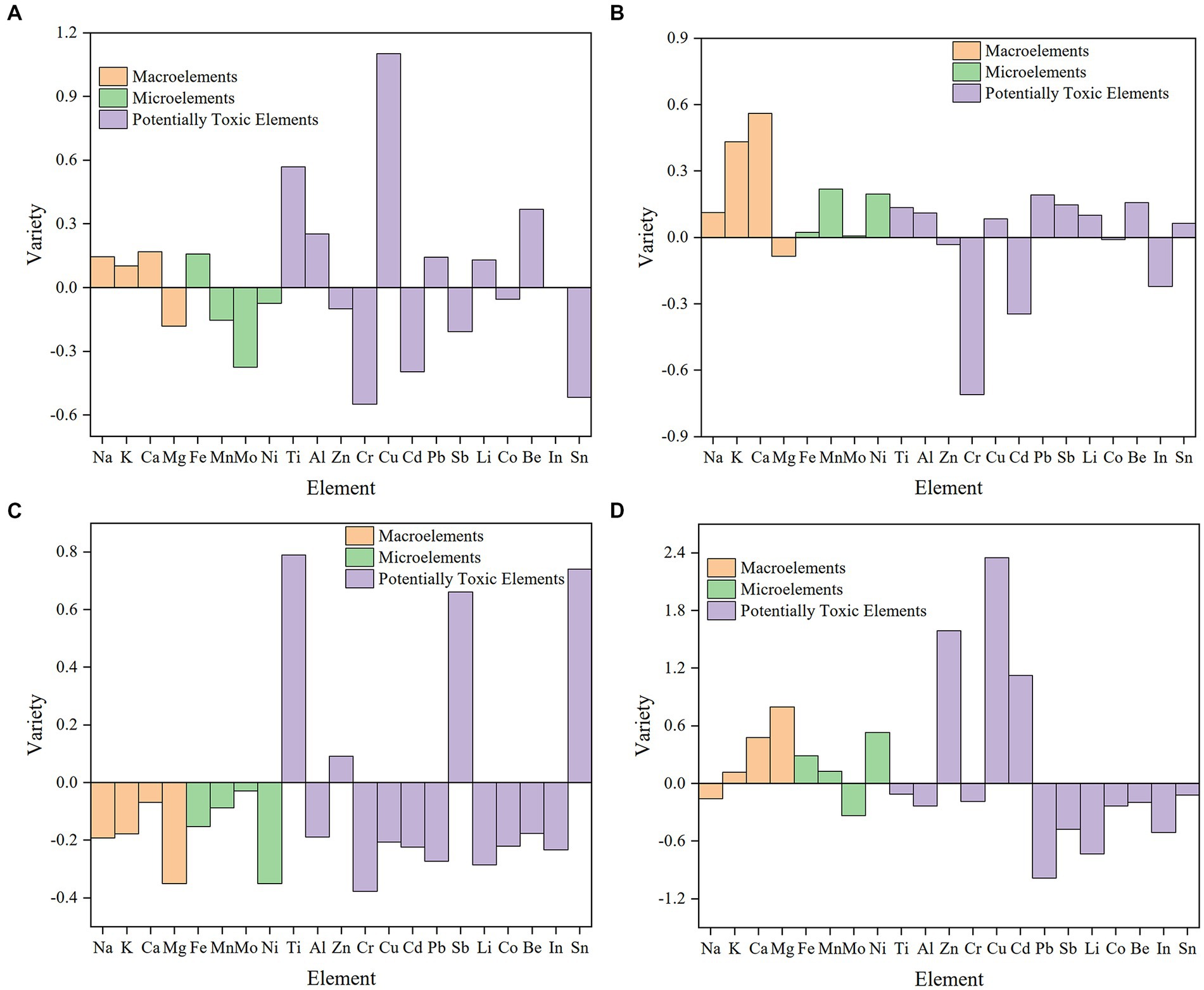
Figure 2. Change direction and amplitude of elements content of each compost material before and after composting. (A) SM; (B) CM; (C) SS; (D) HW.
3.2. Evolution of microelements content during composting of organic waste
In addition to the macroelements, the organic wastes studied also contained some microelements (Fe, Mn, Zn, Cu, Mo, Ni) important for plant growth. As shown in Figure 3, the contents of Fe and Mn in SS and its final compost were remarkably higher than in other organic waste. The high contents of Fe and Mn in the soil of Hunan Province precisely confirmed the long-term use of SS for composting in this area. Metals in soils may be described as belonging to different fractions, including soluble, exchangeable, bound to carbonates, bound to Fe-Mn oxides, and residual. The metals bound to Fe-Mn oxides can be released at low Eh (Taiwo et al., 2016). The content of Fe increased in the SM, CM, and HW compost, with the maximum increase (28.74%) observed in the HW compost. This most likely resulted from the breakdown of organic compounds. High molecular weight organic substances may undergo rapid breakdown during the composting process (including polysaccharides such as lignin, cellulose, proteins, and others). These compounds could break down into low molecular weight organic compounds with carboxyl and phenol groups as byproducts. The metals under study demonstrated a strong molecular propensity for forming complexes with organic substances. The contents of all microelements decreased in SS compost most likely due to leaching by water.
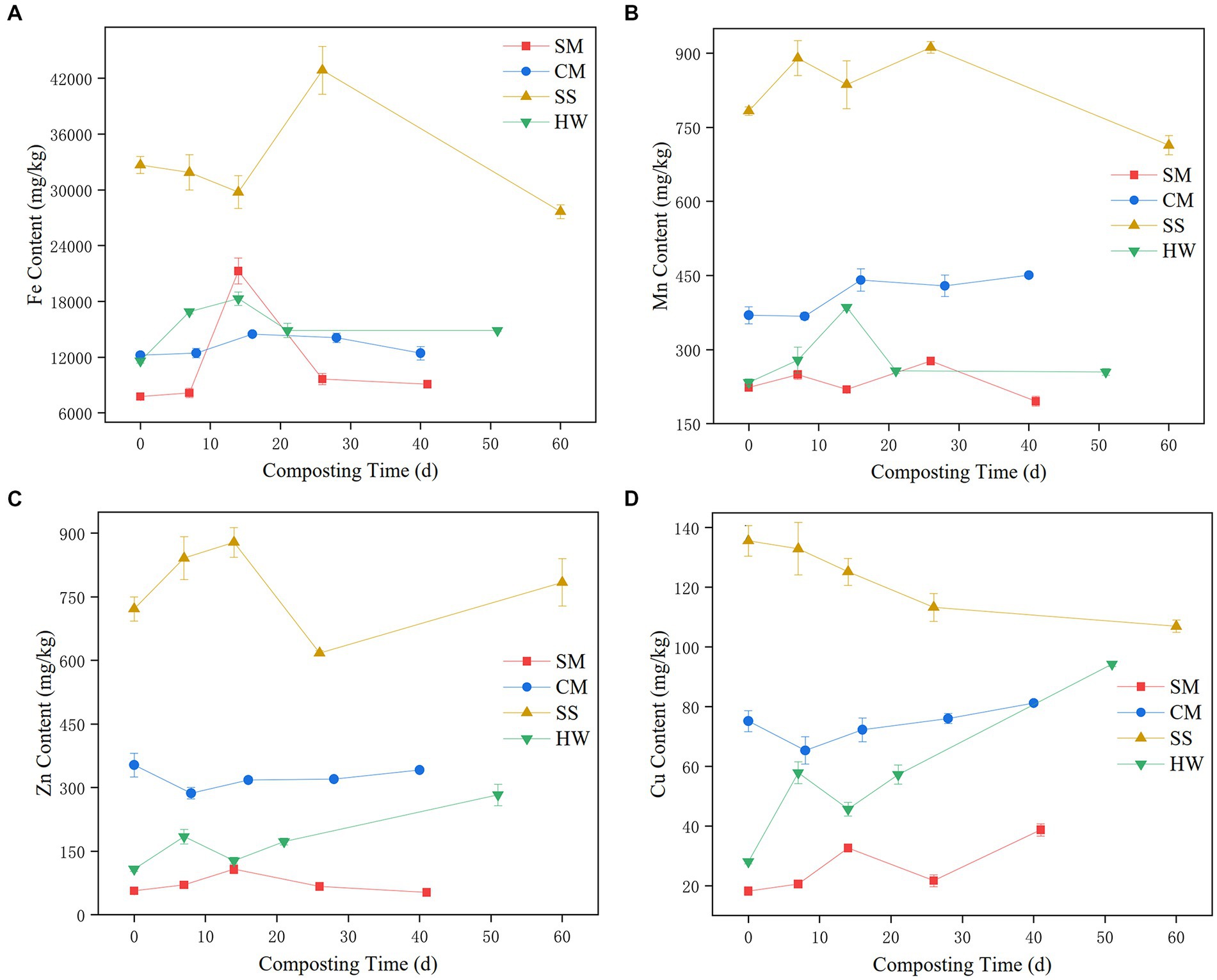
Figure 3. The evolution of microelements content during composting of organic waste. (A) Fe; (B) Mn; (C) Zn; (D) Cu.
Zn was mostly found in fraction III of the organic waste, where it was coupled with Fe-Mn oxides and made up to 70% of the total content, as well as 20% of the total content in the form of carbonates. Zn is a metal that has a strong affinity for carbonates, making it simple to precipitate and coprecipitate with those substances (Zheng et al., 2022). Therefore, the Zn contents in the SM, CM, and SS remained relatively constant except in the HW.
Cu plays an important role in several physiological processes in plants, e.g., supporting disease resistance, photosynthesis, respiration, carbohydrate distribution, N and cell wall metabolism, and seed production (Ramos Marques et al., 2022). Cu is generally regarded as harmless, but at elevated contents, Cu toxicity in humans can result in abnormalities of kidney functions (Zhen et al., 2022). Cu contents in the compost in the current study ranged from 38.9 to 108 mg/kg. Cu contents in SM and HW were significantly raised by 110.27 and 234.98%, respectively, at the conclusion of the composting period.
3.3. Evolution of potentially toxic elements content during composting of organic waste
An important assessment criterion of compost in view of its environmental applications (mainly in agriculture) is determining its potential toxic elements content, especially whether the heavy metal content is below regulatory levels. The threshold limits for heavy metals in mg/kg are as follows: Cd (10), Cr (500), Co (100), Sb (25), and Pb (200) (Chinese standard GB 18382–2021). The Chinese standard does not apply to the other toxicant heavy metals that were evaluated here. To investigate the effects of composting on the pollution risk of organic waste compost, measurements of 11 potential toxic elements (Ti, Al, Cr, Cd, Pb, Sb, Li, Co, Be, In, and Sn) were made (Figure 4).
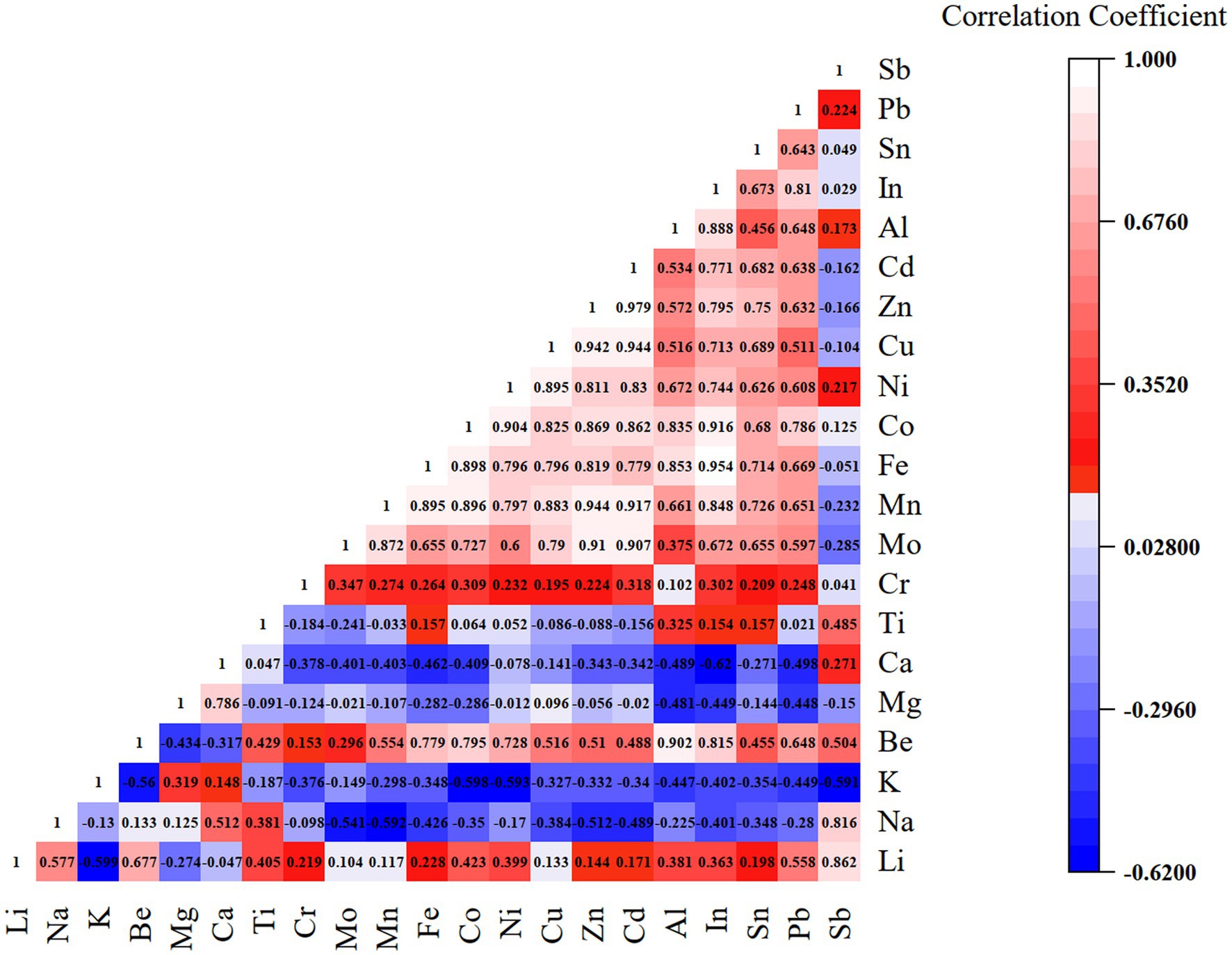
Figure 4. Correlation heatmap of selected nutrient elements and potentially toxic elements variables in organic waste and its compost products.
Ti is a plant biostimulant that supports biological processes, growth, and development, and affects physiological and biochemical pathways, often increasing biomass production and enhancing plant yield. In addition to increased plant growth, Ti supplementation may support improved chlorophyll production, pollination, and fruit and seed formation (Gabriel Perez-Zavala et al., 2022). As shown in Figure 5A, Ti contents in the compost samples were found to vary from 825 to 1,333 mg/kg. Especially notable was the content of Ti in the SS, which was not influenced by water leaching and increased by a substantial amount (78.93%) after composting. Nevertheless, as previously indicated, the Chinese national standard presently does not specify threshold levels for Zn, Al, Ti and Cu.
The compost products were characterized by very high contents of Al, with the highest amount (39,112 mg/kg) found in the SS compost (Figure 5B). The activated sludge process used to treat sewage wastewater generally involves the addition of polyaluminum chlorides to coagulate the excess sludge; therefore, even after the completion of composting, there could be a certain degree of residual Al (de Souza et al., 2019). The addition of Al to soils may cause negative effects such as the inhibition of phosphatase, catalase dehydrogenase, and invertase activities (Qian et al., 2023).
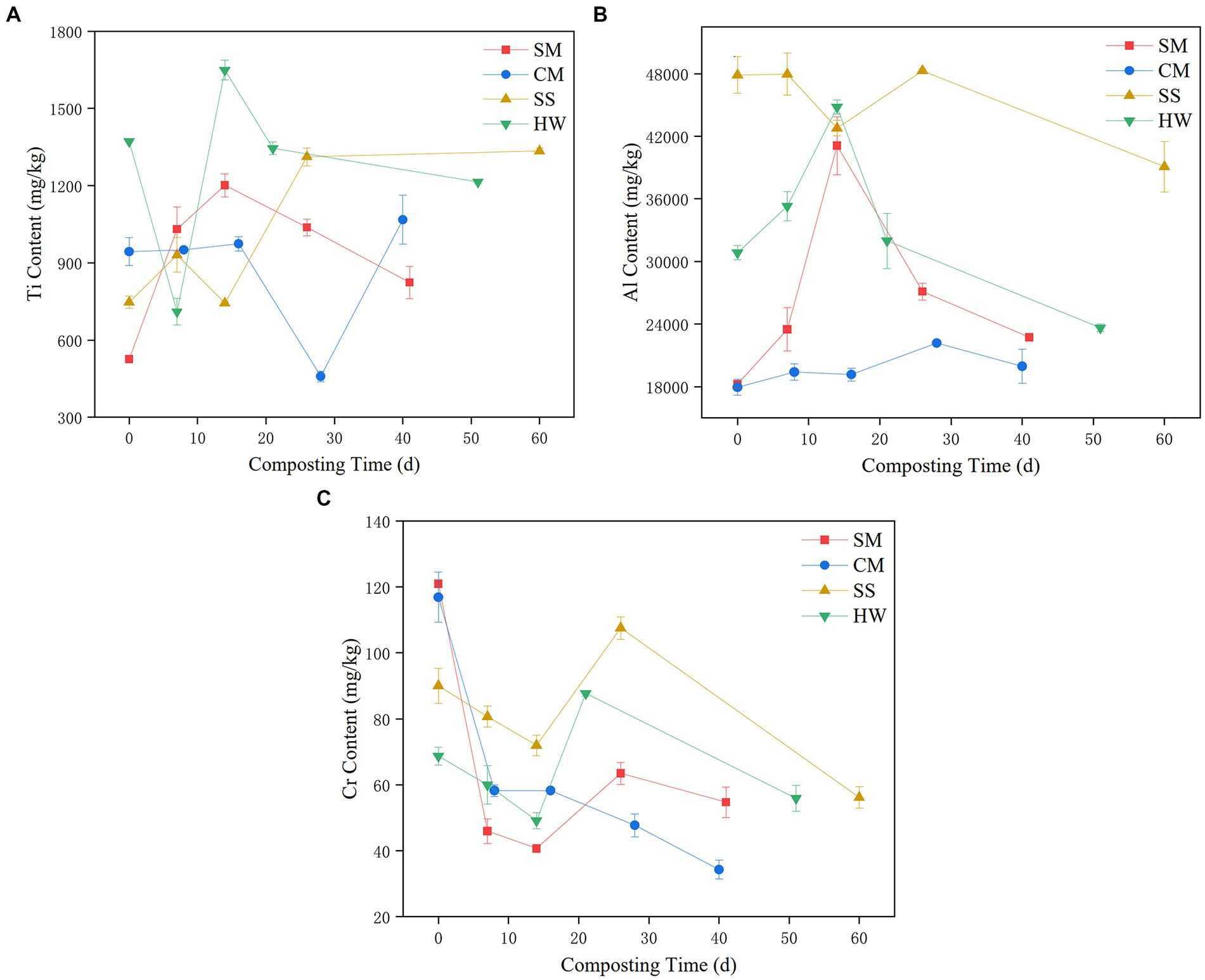
Figure 5. The evolution of potentially toxic elements content during composting of organic waste. (A) Ti; (B) Al; (C) Cr.
Cd and Pb are particularly concerning in plants due to their high potential for accumulation in leaves. One class of extremely hazardous metals that are easily transformed in both aquatic and soil environments includes Cd and Pb (Chen et al., 2019). Our results indicated that the contents of Cd, Pb, Cr, Sb, and Co in all composts did not exceed the threshold limits (Chinese standard GB 18382–2021) for use in agriculture (Figure 5C). Furthermore, contents of Li, Be, In, and Sn in the organic waste composts were low and ranged from 8.65–26.9 mg/kg for Li, 0.726–1.36 mg/kg for Be, 0.014–0.072 mg/kg for In, and 0.181–2.96 mg/kg for Sn.
3.4. PCA for the nutrient elements and potentially toxic elements in compost
To comprehend in detail how composting affects the nutrient elements and potentially toxic elements in the different organic waste and compost products, PCA was performed on element contents before and after composting. The contributions of PC1, PC2, PC3, and PC4 were 51.49, 18.52, 10.13, and 6.46%, respectively, and the cumulative variance of the first four principal components contributions was 86.60%. The first two main components that were representative were chosen based on the PCA general principles. The primary variable affecting the impact of composting on the examined elements was PC1, which contributed 51.49% to the total. In Figure 6B, considerable differences in nutrient elements and potentially toxic elements were observed in the PC1 and PC2 directions of different organic waste before and after composting, and this difference was significant. For example, SS exhibited different characteristics compared to other composting materials due to its high moisture content, while CM and SM were both composted from animal manure and had certain similarities.
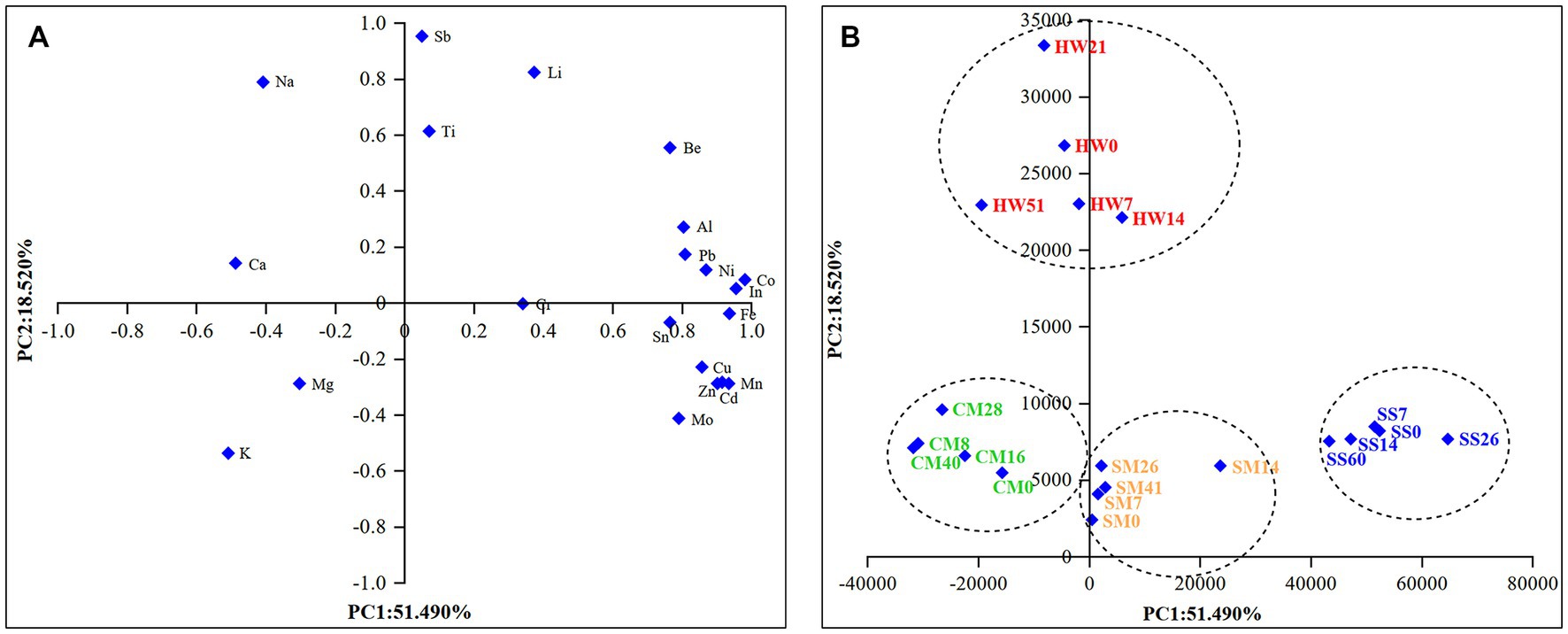
Figure 6. Principal component analysis (PCA). (A) PCA loadings for 21 nutrient elements and potentially toxic elements compounds; (B) PCA scores for organic waste and compost samples.
To further analyze the contributions of the 21 elements to the two principal components, a factor loading plot was also built. In the PCA factor loading plot (Figure 6A), the macroelement (Na, K, Ca, Mg) contents negatively correlated with PC1, whereas microelement and potentially toxic element positively correlated with PC1. As shown in Figure 6A, Sb and Co each made the largest contributions to PC1, and PC2, respectively. The microelements (Fe, Mn, Zn, Cu, Mo, Ni) were all positively correlated with each other, and these PCA results indicated that the effects of composting on nutrient elements and potentially toxic elements are somewhat different and significant.
Composting is the only way to develop green agriculture and carry out harmless and resourceful utilization of urban and rural waste. However, if potentially toxic elements are present in compost products, they will pose a great risk to soil, water environments and human health. Therefore, improving fertilizer quality and safety is an important requirement in the development of the composting industry. In this study, the Cu content in HW more than doubled after composting. Therefore, an approach that controls potentially toxic elements in organic wastes at the source and during relevant industrial processes and performs treatment after use should be carried out. For example, this could include the standardized addition of feed additives in chicken farms, the precipitation and separation of heavy metals in the anaerobic digesters of sewage treatment plants, or the use of additives such as biochar for in situ passivation. At the same time, relevant laws on the content limits of potentially toxic elements such as Al, Ti, Zn, and Cu should be further formulated and improved. Having clearly established limits will help lay the foundations for creating improved composting technology and management measures, thereby strengthening the control of potentially toxic elements during composting and, finally, promoting the development of green agriculture.
4. Conclusion
This study provides new insights into the dynamic changes of various nutrient elements and potentially toxic elements during the composting process of different materials. Our research results indicate that composting treatment influenced the contents of macroelements (Na, K, Ca, Mg), microelements (Fe, Mn, Zn, Cu, Mo, Ni), and potentially toxic elements (Ti, Al, Cr, Cd, Pb, Sb, Li, Co, Be, In, and Sn) in organic wastes to varying degrees. Most of the potentially toxic elements in SM, CM, and HW were relatively concentrated during the composting process due to organic decomposition and weight loss. However, most of the potential toxic elements in SS were lost due to water leaching. Furthermore, the dynamic changes of nutrient elements and potentially toxic elements differed significantly between composting materials. Therefore, the elimination of potentially toxic elements during composting should be further studied in the future to ensure more resourceful and reasonable composting and the sustainable utilization of different organic wastes in agriculture.
Data availability statement
The raw data supporting the conclusions of this article will be made available by the authors, without undue reservation.
Author contributions
WT and BX conceived the experiments. YG and SW performed the experiments. YG, SW, and WT analyzed the data. YG and BX wrote this manuscript. All authors contributed to the article and approved the submitted version.
Funding
This study was supported by the National Natural Science Foundation of China (No. 42030704).
Acknowledgments
The authors express their sincere gratitude to the Lincoln G. in Emerald Publishing (www.emeraldchina.com.cn) for providing language editing services.
Conflict of interest
The authors declare that the research was conducted in the absence of any commercial or financial relationships that could be construed as a potential conflict of interest:
Publisher’s note
All claims expressed in this article are solely those of the authors and do not necessarily represent those of their affiliated organizations, or those of the publisher, the editors and the reviewers. Any product that may be evaluated in this article, or claim that may be made by its manufacturer, is not guaranteed or endorsed by the publisher.
References
Alvarenga, P., Mourinha, C., Farto, M., Santos, T., Palma, P., Sengo, J., et al. (2015). Sewage sludge, compost and other representative organic wastes as agricultural soil amendments: Benefits versus limiting factors. Waste Manag. 44:227. doi: 10.1016/j.wasman.2015.07.027
Antonkiewicz, J., Poplawska, A., Kolodziej, B., Ciarkowska, K., Gambus, F., Bryk, M., et al. (2020). Application of ash and municipal sewage sludge as macronutrient sources in sustainable plant biomass production. J. Environ. Manag. 264:110450. doi: 10.1016/j.jenvman.2020.110450
Arshadi, M. (2015). Manganese chloride nanoparticles: A practical adsorbent for the sequestration of Hg(II) ions from aqueous solution. Chem. Eng. J. 259, 170–182. doi: 10.1016/j.cej.2014.07.111
Chazirakis, P., Giannis, A., and Gidarakos, E. (2023). Material flow and environmental performance of the source segregated biowaste composting system. Waste Manag. 160, 23–34. doi: 10.1016/j.wasman.2023.02.005
Chen, Y., Chen, Y., Li, Y., Wu, Y., Zeng, Z., Xu, R., et al. (2019). Changes of heavy metal fractions during co-composting of agricultural waste and river sediment with inoculation of Phanerochaete chrysosporium. J. Hazard. Mater. 378:120757. doi: 10.1016/j.jhazmat.2019.120757
Chen, X., Du, Z., Song, X., Wang, L., Wei, Z., Jia, L., et al. (2023). Evaluating the occurrence frequency of horizontal gene transfer induced by different degrees of heavy metal stress. J. Clean. Prod. 382:135371. doi: 10.1016/j.jclepro.2022.135371
Chen, H., He, J., Zhou, D., Zhang, Z., Yao, J., Qiu, Z., et al. (2022). Introduction of acid-neutralizing layer to facilitate the stabilization of municipal solid waste landfill. Waste Manag. 154, 245–251. doi: 10.1016/j.wasman.2022.10.013
de Souza, B., Amaral Sobrinho, N. M. B. d., Lima, E. S. A., Lima, J. d. O., Carmo, M. G. F. d., and García, A. C. (2019). Relation between changes in organic matter structure of poultry litter and heavy metals solubility during composting. J. Environ. Manag. 247, 291–298. doi: 10.1016/j.jenvman.2019.06.072
Gabriel Perez-Zavala, F., Atriztan-Hernandez, K., Martinez-Irastorza, P., Oropeza-Aburto, A., Lopez-Arredondo, D., and Herrera-Estrella, L. (2022). Titanium nanoparticles activate a transcriptional response in Arabidopsis that enhances tolerance to low phosphate, osmotic stress and pathogen infection. Front. Plant Sci. 13:994523. doi: 10.3389/fpls.2022.994523
Guo, H., Zhao, Y., Damgaard, A., Wang, Q., Lu, W., Wang, H., et al. (2019). Material flow analysis of alternative biorefinery systems for managing Chinese food waste. Resour. Conserv. Recycl. 149, 197–209. doi: 10.1016/j.resconrec.2019.05.010
Huang, S., Ma, Q., Hou, Q., Zuo, T., Zhang, Z., and Ni, W. (2021). Identification and quantitative chemical analysis of betaines in different organic wastes and their bioconversion composts. Bioresour. Technol. 328:124857. doi: 10.1016/j.biortech.2021.124857
Jazi, M. B., Arshadi, M., Amiri, M. J., and Gil, A. (2014). Kinetic and thermodynamic investigations of Pb(II) and Cd(II) adsorption on nanoscale organo-functionalized SiO2-Al2O3. J. Colloid Interface Sci. 422, 16–24. doi: 10.1016/j.jcis.2014.01.032
Knoop, C., Tietze, M., Dornack, C., and Raab, T. (2018). Fate of nutrients and heavy metals during two-stage digestion and aerobic post-treatment of municipal organic waste. Bioresour. Technol. 251, 238–248. doi: 10.1016/j.biortech.2017.12.019
Li, R., Hao, H., Yang, C., Wang, L., and Wang, H. (2022). Rabbit manure compost as a peat substitute for compound growing media: Proportioning optimization according to physiochemical characteristics and seedling effects. Front. Plant Sci. 13:1008089. doi: 10.3389/fpls.2022.1008089
Maathuis, F. J. M. (2009). Physiological functions of mineral macronutrients. Curr. Opin. Plant Biol. 12, 250–258. doi: 10.1016/j.pbi.2009.04.003
Manca, A., da Silva, M. R., Guerrini, I. A., Fernandes, D. M., Villas Boas, R. L., da Silva, L. C., et al. (2020). Composted sewage sludge with sugarcane bagasse as a commercial substrate for Eucalyptus urograndis seedling production. J. Clean. Prod. 269:122145. doi: 10.1016/j.jclepro.2020.122145
Mohan, D., Kumar, H., Sarswat, A., Alexandre-Franco, M., and Pittman, C. U. Jr. (2014). Cadmium and lead remediation using magnetic oak wood and oak bark fast pyrolysis bio-chars. Chem. Eng. J. 236, 513–528. doi: 10.1016/j.cej.2013.09.057
Nguyen, M. K., Lin, C., Hong Giang, H., Sanderson, P., Bao Trong, D., Xuan Thanh, B., et al. (2022). Evaluate the role of biochar during the organic waste composting process: A critical review. Chemosphere 299:134488. doi: 10.1016/j.chemosphere.2022.134488
Qian, S., Zhou, X., Fu, Y., Song, B., Yan, H., Chen, Z., et al. (2023). Biochar-compost as a new option for soil improvement: Application in various problem soils. Sci. Total Environ. 870:162024. doi: 10.1016/j.scitotenv.2023.162024
Ramos Marques, A. C., Hindersmann, J., Trentin, E., De Conti, L., Drescher, G. L., Somavilla, A., et al. (2022). Physiological and biochemical characterization of copper-toxicity tolerance mechanism in grass species native to Pampa Biome and Atlantic Forest for use in phytoremediation. Environ. Sci. Pollut. Res. 30, 5076–5088. doi: 10.1007/s11356-022-22570-3
Salomon, M. J., Watts-Williams, S. J., McLaughlin, M. J., Brien, C. J., Jewell, N., Berger, B., et al. (2021). Evaluation of commercial composts and potting mixes and their ability to support arbuscular mycorrhizal fungi with maize (Zea mays) as host plant. Waste Manag. 134, 187–196. doi: 10.1016/j.wasman.2021.08.018
Taiwo, A. M., Gbadebo, A. M., Oyedepo, J. A., Ojekunle, Z. O., Alo, O. M., Oyeniran, A. A., et al. (2016). Bioremediation of industrially contaminated soil using compost and plant technology. J. Hazard. Mater. 304, 166–172. doi: 10.1016/j.jhazmat.2015.10.061
Tessier, A., Campbell, P. G. C., and Bisson, M. (1979). Sequential extraction procedure for the speciation of particulate trace-metals. Anal. Chem. 51, 844–851. doi: 10.1021/ac50043a017
Winkler, J., Matsui, Y., Filla, J., Vykydalova, L., Jirousek, M., and Vaverkova, M. D. (2023). Responses of synanthropic vegetation to composting facility. Sci. Total Environ. 859:160160. doi: 10.1016/j.scitotenv.2022.160160
Xiang, M., Li, Y., Yang, J., Lei, K., Li, Y., Li, F., et al. (2021). Heavy metal contamination risk assessment and correlation analysis of heavy metal contents in soil and crops. Environ. Pollut. 278:116911. doi: 10.1016/j.envpol.2021.116911
Xu, M., Yang, M., Xie, D., Ni, J., Meng, J., Wang, Q., et al. (2021). Research trend analysis of composting based on Web of Science database. Environ. Sci. Pollut. Res. 28, 59528–59541. doi: 10.1007/s11356-021-16377-x
Yan, Y., Wu, W., Huang, C., Li, W., and Li, Y. (2023). Coupling network of hydrogen sulfide precursors and bacteria in kitchen waste composting. Bioresour. Technol. 372:128655. doi: 10.1016/j.biortech.2023.128655
Zhao, X., Xi, B., He, X., Li, D., Tan, W., Zhang, H., et al. (2019). The impacts of metal ions on phytotoxicity mediate by microbial community during municipal solid waste composting. J. Environ. Manag. 242, 153–161. doi: 10.1016/j.jenvman.2019.04.063
Zhen, Y., Ge, L., Chen, Q., Xu, J., Duan, Z., Loor, J. J., et al. (2022). Latent benefits and toxicity risks transmission chain of high dietary copper along the livestock-environment-plant-human health axis and microbial homeostasis: A review. J. Agric. Food Chem. 70, 6943–6962. doi: 10.1021/acs.jafc.2c01367
Keywords: compost, macroelements, microelements, potentially toxic elements, household waste, sewage sludge, chicken manure, cow/sheep manure
Citation: Gao Y, Wang S, Tan W and Xi B (2023) Dynamics of nutrient elements and potentially toxic elements during composting with different organic wastes. Front. Sustain. Food Syst. 7:1181392. doi: 10.3389/fsufs.2023.1181392
Edited by:
Arif Reza, University of Idaho, United StatesReviewed by:
Luciana Maria Saran, São Paulo State University, BrazilJuan Fernando Hirzel, Agricultural Research Institute, Chile
Copyright © 2023 Gao, Wang, Tan and Xi. This is an open-access article distributed under the terms of the Creative Commons Attribution License (CC BY). The use, distribution or reproduction in other forums is permitted, provided the original author(s) and the copyright owner(s) are credited and that the original publication in this journal is cited, in accordance with accepted academic practice. No use, distribution or reproduction is permitted which does not comply with these terms.
*Correspondence: Wenbing Tan, d2VuYmluZ3RhbkAxMjYuY29t
 Yiman Gao
Yiman Gao Shuhan Wang2
Shuhan Wang2 Wenbing Tan
Wenbing Tan